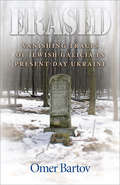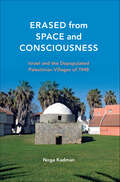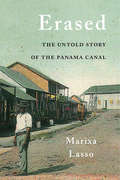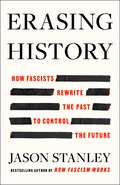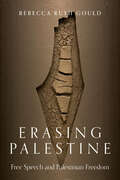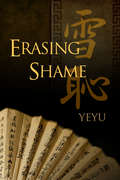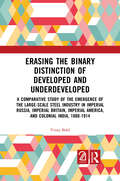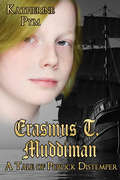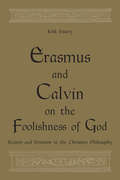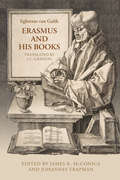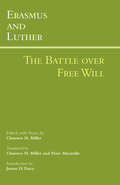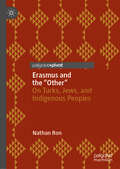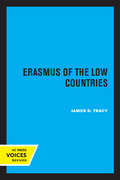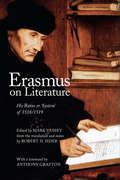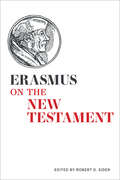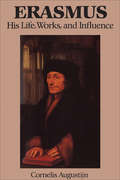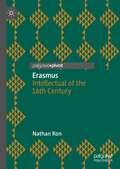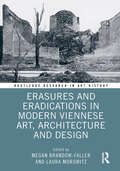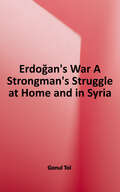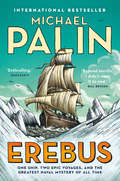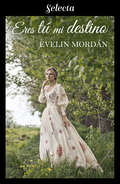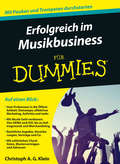- Table View
- List View
Erased
by Omer BartovIn Erased, Omer Bartov uncovers the rapidly disappearing vestiges of the Jews of western Ukraine, who were rounded up and murdered by the Nazis during World War II with help from the local populace. What begins as a deeply personal chronicle of the Holocaust in his mother's hometown of Buchach--in former Eastern Galicia--carries him on a journey across the region and back through history. This poignant travelogue reveals the complete erasure of the Jews and their removal from public memory, a blatant act of forgetting done in the service of a fiercely aggressive Ukrainian nationalism. Bartov, a leading Holocaust scholar, discovers that to make sense of the heartbreaking events of the war, he must first grapple with the complex interethnic relationships and conflicts that have existed there for centuries. Visiting twenty Ukrainian towns, he recreates the histories of the vibrant Jewish and Polish communities who once lived there-and describes what is left today following their brutal and complete destruction. Bartov encounters Jewish cemeteries turned into marketplaces, synagogues made into garbage dumps, and unmarked burial pits from the mass killings. He bears witness to the hastily erected monuments following Ukraine's independence in 1991, memorials that glorify leaders who collaborated with the Nazis in the murder of Jews. He finds that the newly independent Ukraine-with its ethnically cleansed and deeply anti-Semitic population--has recreated its past by suppressing all memory of its victims. Illustrated with dozens of hauntingly beautiful photographs from Bartov's travels, Erased forces us to recognize the shocking intimacy of genocide.
Erased from Space and Consciousness: Israel and the Depopulated Palestinian Villages of 1948
by Noga KadmanHundreds of Palestinian villages were left empty across Israel when their residents became refugees after the 1948 war, their lands and property confiscated. Most of the villages were razed by the new State of Israel, but in dozens of others, communities of Jews were settled—many refugees in their own right. The state embarked on a systematic effort of renaming and remaking the landscape, and the Arab presence was all but erased from official maps and histories. Israelis are familiar with the ruins, terraces, and orchards that mark these sites today—almost half are located within tourist areas or national parks—but public descriptions rarely acknowledge that Arab communities existed there within living memory or describe how they came to be depopulated. Using official archives, kibbutz publications, and visits to the former village sites, Noga Kadman has reconstructed this history of erasure for all 418 depopulated villages.
Erased: The Untold Story of the Panama Canal
by Marixa LassoCutting a path from the Atlantic to the Pacific, the Panama Canal set a new course for the development of Central America—but at considerable cost to Panamanians. Sleuth and scholar Marixa Lasso recounts how the canal’s American builders displaced 40,000 residents and erased entire towns in the guise of bringing modernity to the tropics.
Erasing History: How Fascists Rewrite the Past to Control the Future
by Jason Stanley&“I&’ve never read a book that is as timely, urgent and essential as this one. A battle plan for keeping this nation from falling into fascism.&” —Khalil Gibran Muhammad, author of The Condemnation of Blackness From the bestselling author of How Fascism Works, a searing confrontation with the far right&’s efforts to rewrite history and undo a century of progress on race, gender, sexuality, and class.The human race finds itself again under threat of a rising global fascist movement. In the United States, democracy is under attack by an authoritarian movement that has found fertile ground among the country&’s conservative politicians and voters, but similar movements have found homes in the hearts and minds of people all across the globe. To understand the shape, form, and stakes of this assault, we must go back to extract lessons from our past. Democracy requires a common understanding of reality, a shared view of what has happened, that informs ordinary citizens&’ decisions about what should happen, now and in the future. Authoritarians target this shared understanding, seeking to separate us from our own history to destroy our self-understanding and leave us unmoored, resentful, and confused. By setting us against each other, authoritarians represent themselves as the sole solution. In authoritarian countries, critical examination of those nations&’ history and traditions is discouraged if not an outright danger to those who do it. And it is no accident that local and global institutions of education have become a battleground, the authoritarian right&’s tip of the spear, where learning and efforts to upend a hierarchal status quo can be put to end by coercion and threats of violence. Democracies entrust schools and universities to preserve a common memory of positive change, generated by protests, social movements, and rebellions. The authoritarian right must erase this history, and, along with it, the very practice of critical inquiry that has so often been the engine of future progress. In Erasing History, Yale professor of philosophy Jason Stanley exposes the true danger of the authoritarian right&’s attacks on education, identifies their key tactics and funders, and traces their intellectual roots. He illustrates how fears of a fascist future have metastasized, from hypothetical threat to present reality. And he shows that hearts and minds are won in our schools and universities—places, he explains, that democratic societies across the world are now ill-prepared to defend against the fascist assault currently underway. Deeply informed and urgently needed, Erasing History is a global call to action for those who wish to preserve democracy—in America and abroad—before it is too late.
Erasing Palestine: Free Speech and Palestinian Freedom
by Rebecca GouldHow the redefinition of antisemitism has functioned as a tactic to undermine Palestine solidarityThe widespread adoption of the IHRA definition of anti-semitism and the internalisation of its norms has set in motion a simplistic definitional logic for dealing with social problems that has impoverished discussions of racism and prejudice more generally, across Britain and beyond. It has encouraged a focus on words over substance.Erasing Palestine tells the story of how this has happened, with a focus on internal politics within Britain over the course of the past several years. In order to do so, it tells a much longer story, about the history of antisemitism since the beginning of the twentieth century. This is also a story about Palestine, a chronicle of the erasure of the violence against the Palestinian people, and a story about free speech, and why it matters to Palestinian freedom.
Erasing Shame
by Yeyu2nd EditionThe son of a Han traitor who had let the Xianbei Mongols invade the borders, Jiang Shicai swears to restore his family's honor, hoping to better the Hans' lives through peaceful means. He believes violence is never the answer, but to gain respect, he finds himself fighting for the Xianbei. Ten years later, an annoying but handsome playboy, Dugu Xuechi, arrives as the incompetent new military inspector of Shicai's region. Shameless, irresponsible, and obnoxious, Xuechi tests Shicai's patience almost every second. Despite their mutual dislike, Shicai finds himself drawn to the capricious man, especially when he sees the resemblance between Xuechi and his deceased best friend. Yet Xuechi's self-destructive behavior and refusal to accept help require attention that distracts Shicai from his goal for peace--and it doesn't help that Xuechi is Shicai's strongest political opposition. Haunted by a childhood promise he never had the chance to fulfill, Shicai must choose between his feelings and his values.First Edition published by Dreamspinner Press, February 2013.
Erasing the Binary Distinction of Developed and Underdeveloped: A Comparative Study of the Emergence of the Large-Scale Steel Industry in Imperial Russia, Imperial Britain, Imperial America, and Colonial India, 1880-1914
by Vinay BahlThis book challenges the binary distinction of developed and underdeveloped in the categorization of any country while proposing to erase this binary with a yardstick of parity. Through a sample comparative historical study focusing on the question of the emergence of the large-scale steel industry (1880-1914) of four chosen countries, two considered "developed" (Imperial UK and Post-colonial Imperial USA) and two considered "underdeveloped" (Imperial Russia and Colonial India), it is shown how this yardstick of parity can be applied without the categorization of societies as either developed or underdeveloped. Print edition not for sale in South Asia (India, Sri Lanka, Nepal, Bangladesh, Pakistan or Bhutan)
Erasmus T Muddiman: A Tale Of Publick Distemper
by Katherine PymIt is London 1665, a year fraught with strange and unearthly events. Comets fly low in the sky while merchants clamor for war. Eleven year old Erasmus T. Muddiman attends St Paul’s School with his younger brother. He enjoys Latin but hates to create Latin verses, preferring the new sciences as seen at the Royal Society. He plays football with the lads in Paul’s Yard, shimmies up the drainpipe outside his bedchamber window and he saves his brother, Desiderius, from all sorts of scrapes. Soon, Erasmus cannot avoid the rumors of war. Men and boys are pressganged, taken to ships or the dockyards. Plague enters the city. As school fellows disappear, Erasmus and his family meet a terrible fate of survival. Who will live and who will die?
Erasmus and Calvin on the Foolishness of God: Reason and Emotion in the Christian Philosophy
by Kirk EssaryWhat did Paul mean when he wrote that the foolishness of God is wiser than human wisdom? Through close analysis of the sixteenth-century reception of Paul's discourses of folly, this book examines the role of the New Testament in the development of what Erasmus and John Calvin refer to as the “Christian philosophy.” Erasmus and Calvin on the Foolishness of God reveals the importance of Pauline rhetoric in the development of humanist critiques of scholasticism while charting the formation of a specifically affective approach to religious epistemology and theological method. As the first book-length examination of Calvin's indebtedness to Erasmus, which also considers the participation of Bullinger, Pellikan, and Melanchthon in an Erasmian exegetical milieu, it is a case study in the complicated cross-confessional exchange of ideas in the sixteenth century. Kirk Essary examines assumptions about the very nature of theology in the sixteenth century, how it was understood by leading humanist reformers, and how ideas about philosophy and rhetoric were received, appropriated, and shared in a complex intellectual and religious context.
Erasmus and His Books (Erasmus Studies)
by J. C. Grayson Egbertus Van Gulik James K. McConica J. TrapmanWhat became of Erasmus’ books? The most famous scholar of his day died in peaceful prosperity and in the company of celebrated and responsible friends. His zeal for useful books was insatiable. Indeed, he had taken care to insure that after his death they would pass to an appreciative noble owner, yet after his death their fate was unknown. Erasmus and His Books provides the most comprehensive evidence available about the books of Erasmus of Rotterdam – the books he owned and his attitude towards them, when and how he acquired them, how he housed, used, and cared for them, and how, from time to time, he disposed of them. Part 1 details the formation, growth, scope, and arrangement of Erasmus’ library and opens the door to a new understanding of the more intimate side of his daily life as a scholar at home with his books, friends, publishers, and booksellers. Part 2 presents a carefully annotated catalogue, the Versandliste, of the more than 400 books in Erasmus’ possession at one point. Drawing upon his command of bibliographical data and his extensive knowledge of Erasmus’ correspondence and related records Egbertus van Gulik proposes as precise an identification of each of the titles as the evidence will allow. Van Gulik’s insightful discoveries tell us what can be known of books in Erasmus’ working library and how he used them and will be of interest to students of the northern Renaissance, the history of the book, and the history of learning.
Erasmus and Luther: The Battle over Free Will
by Clarence H. Miller James D. Tracy Peter MacardleThis compilation of writings from Erasmus and Luther's great debate--over free will and grace, and their respective efficacy for salvation--offers a fuller representation of the disputants' main arguments than has ever been available in a single volume in English. Included are key, corresponding selections from not only Erasmus' conciliatory A Discussion or Discourse concerning Free Will and Luther's forceful and fully argued rebuttal, but--with the battle now joined--from Erasmus' own forceful and fully argued rebuttal of Luther. Students of Reformation theology, Christian humanism, and sixteenth-century rhetoric will find here the key to a wider appreciation of one of early modern Christianity's most illuminating and disputed controversies.
Erasmus and Voltaire
by Ricardo J. QuinonesDespite comparisons between Erasmus and Voltaire having become common-place in the course of the nineteenth century, this is the first full study to bring them together in their careers, their works, and their historic afterlives. Each was a force for change in his time and thus ranks among the masters of modern liberalism. Beginning with the continuities between the Renaissance and the Enlightenment, award-winning scholar Ricardo J. Quinones joins Erasmus and Voltaire as voices of moderation and reason that remain capable of addressing the philosophical crises of twentieth-century thought.A companion piece to Dualisms, Quinones' 2007 book, Erasmus and Voltaire differs in method: where its predecessor looked to inveterate, unyielding differences, this new work looks to similarities. In delving beneath the obvious differences between these two intellectual giants, Quinones uncovers the great practical and spiritual vocations that unite them.
Erasmus and the “Other”: On Turks, Jews, and Indigenous Peoples
by Nathan RonThis book investigates how Erasmus viewed non-Christians and different races, including Muslims, Jews, the indigenous people of the Americas, and Africans. Nathan Ron argues that Erasmus was devoted to Christian Eurocentrism and not as tolerant as he is often portrayed. Erasmus’ thought is situated vis-à-vis the thought of contemporaries such as the cosmographer and humanist Aeneas Sylvius Piccolomini who became Pope Pius II; the philosopher, scholar, and Cardinal, Nicholas of Cusa; and the Dominican missionary and famous defender of the Native Americans, Bartolomé Las Casas. Additionally, the relatively moderate attitude toward Islam which was demonstrated by Michael Servetus, Sebastian Franck, and Sebastian Castellio is analyzed in comparison with Erasmus’ harsh attitude toward Islam/Turks.
Erasmus of Rotterdam
by Christine Christ von-WedelThis book provides the first analysis of the development of Erasmus' historical methodology and its impact on Roman Catholic and Protestant theologians. Combining a biography of Erasmus with the larger theological debates and the intellectual history of his time, Christine Christ-von Wedel reveals many of previously unexplored influences on Erasmus, as well as his influences on his contemporaries.Erasmus of Rotterdam is a revised and considerably enlarged translation of Christ-von Wedel's well-received 2003 study, originally published in German. Observing the influence of classical, biblical, patristic, scholastic, and late medieval vernacular and popular sources on Erasmus' writing, the author provides comparisons with theologians Agrippa, Lefèvre d'Étaples, Eck, Luther, and Zwingli to demonstrate not only the singularity of Erasmus' intellect, but also the enormous impact he had on the Reformation. The result is a lively picture of the man and his time, in which Erasmus emerges as both a devout Christian and a critical seeker of truth who conceded the ambiguities that he could not resolve.
Erasmus of the Low Countries
by James D. TracyFew historical figures have been more important in modeling the ideal of impartial critical scholarship than Erasmus of Rotterdam (1469-1536). Yet his critical scholarship, though beholden to no one, was not dispassionate. James Tracy shows how Erasmus the scholar sought through his writings to promote the moral and religious renewal of Christian society. Tracy finds the genesis of the humanist's notion of a "Christian republic" of pious and learned individuals in his "Burgundian," or Low Countries, roots. Erasmus's vision of reform, Tracy argues, sprung from a humanist tradition focusing on the importance of teaching (doctrina), a tradition from which Erasmus departed in his optimism about human nature and his deep suspicion of the powers that be. Amid the storms of Reformation controversy, he pruned back the "dissimulation" by which he had thought to convey different meanings to different readers, yet in the end he could not control the way his words were read. If Erasmus's scholarly ideal carries an enduring fascination, so too does his dilemma as a man of circumspection who would also be a reformer. This title is part of UC Press's Voices Revived program, which commemorates University of California Press’s mission to seek out and cultivate the brightest minds and give them voice, reach, and impact. Drawing on a backlist dating to 1893, Voices Revived makes high-quality, peer-reviewed scholarship accessible once again using print-on-demand technology. This title was originally published in 1966.
Erasmus on Literature: His Ratio or ‘System’ of 1518/1519 (Erasmus Studies)
by Robert D. SiderNone of the works included among Erasmus’ ‘Literary and Educational Writings’ in the Collected Works of Erasmus captures his most adventurous thinking about how texts signify in – and thereby make or remake – worlds of thought, feeling, and action. The one that comes closest to doing so, the Ratio verae theologiae (‘A System of True Theology’), was first published separately in 1518 and 1519, then appeared in the preliminaries to the New Testament in Erasmus’ (revised) 1519 edition. This handy Ratio or compendious ‘System’ gave advice on how to interpret complex texts and develop persuasive arguments based upon them. Its lessons were applied to the canonical Scriptures as source, and to everyday Christian theology as target discourse. They unfold in response to the special difficulties and incitements of the biblical text in Latin and Greek, within a framework provided by classical grammar and rhetoric, adjusted to the examples of the Church Fathers as exemplary interpreters of the Bible. At every turn, the Ratio reveals the instincts and intuitions of an exceptional theorist and practitioner of the cognitive, social, and political arts of written language. This student edition, the first of its kind in any language, is based on the translation and notes by Robert D. Sider in the Collected Works of Erasmus Volume 41 . It is designed to make it easier to estimate the long-term value of this particular work and of Erasmus’ works more generally, and to allow for a multidisciplinary understanding of the lives of human beings as symbol-using creatures in worlds constructed partly by texts.
Erasmus on the New Testament: New Testament Scholarship: Paraphrase On The Acts Of The Apostles (Erasmus Studies #50)
by Robert SiderWhen Erasmus, at Cambridge in 1512, began to mark up his copy of the Vulgate Bible with a few alternative Latin translations and a biting comment here and there in Latin, he could not have guessed that his work would grow over the next twenty-three years into the twenty volumes currently being produced as annotated translations in The Collected Works of Erasmus. Paraphrases vastly expanded the text of the New Testament books, and brought dynamic and controversial interpretations to the traditional reading of the Latin texts. A new translation based on the Greek text, the first ever to be published by a printing firm, became the basis for ever-expanding notes that explained the Greek, measured the contemporary church against the truth revealed by the Greek, taunted critics and opponents, and revealed the mind of a humanist at work on the Scriptures. The sheer vastness of the work that finally accumulated is almost beyond the reach of a single individual. By excerpts chosen over the entire extent of Erasmus’ New Testament work, this book hopes to reduce that immensity to manageable size, and bring the rich, virtually unlimited treasure of the Erasmian mind on the Scriptures within the comfortable reach of every interested individual.
Erasmus: His Life, Works, and Influence
by Cornelis Augustijn J. C. GraysonErasmus: His Life, Works, and Influence is a comprehensive introduction to Erasmus's life, works, and thoughts. It integrates the best scholarship of the past twenty years and will appeal to undergraduates in all areas of cultural history as well as Erasmus specialists.
Erasmus: Intellectual of the 16th Century
by Nathan RonThis book is a sequel to Nathan Ron's Erasmus and the “Other.” Should we consider Erasmus an involved or public intellectual alongside figures such as Machiavelli, Milton, Locke, Voltaire, and Montesquieu? Was Erasmus really an independent intellectual? In Ron's estimation, Erasmus did not fully live up to his professed principles of Christian peace. Despite the anti-war preaching so eminent in his writings, he made no stand against the warlike and expansionist foreign policies of specific European kings of his era, and even praised the glory won by Francis I on the battlefield of Marignano (1515). Furthermore, in the face of Henry VIII’s execution of his beloved Thomas More and John Fisher, and the atrocities committed by the Spanish against indigenous peoples in the New World, Erasmus preferred self-censorship to expressions of protest or criticism and did not step forward to reproach kings of their misdeeds or crimes.
Erasures and Eradications in Modern Viennese Art, Architecture and Design (Routledge Research in Art History)
by Laura Morowitz Megan Brandow-FallerErasures and Eradications in Modern Viennese Art, Architecture and Design challenges the received narrative on the artists, exhibitions, and interpretations of Viennese Modernism. The book centers on three main erasures—the erasure of Jewish artists and critics; erasures relating to gender and sexual identification; and erasures of other marginalized figures and movements. Restoring missing elements to the story of the visual arts in early twentieth-century Vienna, authors investigate issues of gender, race, ethnic and sexual identity, and political affiliation. Both well-studied artists and organizations—such as the Secession and the Austrian Werkbund, and iconic figures such as Klimt and Hoffmann—are explored, as are lesser known figures and movements. The book’s thought-provoking chapters expand the chronological contours and canon of artists surrounding Viennese Modernism to offer original, nuanced, and rich readings of individual works, while offering a more diverse portrait of the period from 1890, through World War II and into the present. The book will be of interest to scholars working in art history, history, design history, architectural history, and European studies.
Erdoğan's War: A Strongman's Struggle at Home and in Syria
by Gonul TolRecep Tayyip Erdoğan, Turkey's pugnacious president, is now the country's longest-serving leader. On his way to the top, he has fought many wars. This book tells the story of those battles against domestic enemies through the lens of the Syrian conflict, which has become part and parcel of Erdoğan's fight to remain in power. Turkey expert Gönül Tol traces Erdoğan's ideological evolution from a conservative democrat to an Islamist and a Turkish nationalist, and explores how this progression has come to shape his Syria policy, changing the course of the war. She paints a vivid picture of the president's constantly shifting strategy to consolidate his rule, showing that these shifts have transformed Turkey's role in post-uprising Syria from an advocate of democracy, to a power fanning the flames of civil war, to an occupier. From the first days of Erdoğan's rule through the failed coup against him, via the Kurdish peace process, the Arab uprisings and the refugee crisis, this compelling, authoritative book tells the story of one man's quest to remain in power--tying together the fates of two countries, and changing them both forever.
Erebus: One Ship, Two Epic Voyages, and the Greatest Naval Mystery of All Time
by Michael PalinIntrepid voyager, writer and comedian Michael Palin follows the trail of two expeditions made by the Royal Navy's HMS Erebus to opposite ends of the globe, reliving the voyages and investigating the ship itself, lost on the final Franklin expedition and discovered with the help of Inuit knowledge in 2014.The story of a ship begins after the defeat of Napoleon at Waterloo, when Great Britain had more bomb ships than it had enemies. The solid, reinforced hulls of HMS Erebus, and another bomb ship, HMS Terror, made them suitable for discovering what lay at the coldest ends of the earth. In 1839, Erebus was chosen as the flagship of an expedition to penetrate south to explore Antarctica. Under the leadership of the charismatic James Clark Ross, she and HMS Terror sailed further south than anyone had been before. But Antarctica never captured the national imagination; what the British navy needed now was confirmation of its superiority by making the discovery, once and for all, of a route through the North-West Passage. Chosen to lead the mission was Sir John Franklin, at 59 someone many considered too old for such a hazardous journey. Nevertheless, he and his men confidently sailed away down the Thames in April 1845. Provisioned for three winters in the Arctic, Erebus and Terror and the 129 men of the Franklin expedition were seen heading west by two whalers in late July. No one ever saw them again. Over the years there were many attempts to discover what might have happened--and eventually the first bodies were discovered in shallow graves, confirming that it had been the dreadful fate of the explorers to die of hunger and scurvy as they abandoned the ships in the ice. For generations, the mystery of what had happened to the ships endured. Then, on September 9th, 2014, came the almost unbelievable news: HMS Erebus had been discovered thirty feet below the Arctic waters, by a Parks Canada exploration ship. Palin looks at the Erebus story through the different motives of the two expeditions, one scientific and successful, the other nationalistic and disastrous. He examines the past by means of the extensive historical record and travels in the present day to those places where there is still an echo of Erebus herself, from the dockyard where she was built, to Tasmania where the Antarctic voyage began and the Falkland Islands, then on to the Canadian Arctic, to get a sense of what the conditions must have been like for the starving, stumbling sailors as they abandoned their ships to the ice. And of course the story has a future. It lies ten metres down in the waters of Nunavut's Queen Maud Gulf, where many secrets wait to be revealed.
Erebus: One Ship, Two Epic Voyages, and the Greatest Naval Mystery of All Time
by Michael PalinIntrepid voyager, writer and comedian Michael Palin follows the trail of two expeditions made by the Royal Navy's HMS Erebus to opposite ends of the globe, reliving the voyages and investigating the ship itself, lost on the final Franklin expedition and discovered with the help of Inuit knowledge in 2014.The story of a ship begins after the defeat of Napoleon at Waterloo, when Great Britain had more bomb ships than it had enemies. The solid, reinforced hulls of HMS Erebus, and another bomb ship, HMS Terror, made them suitable for discovering what lay at the coldest ends of the earth. In 1839, Erebus was chosen as the flagship of an expedition to penetrate south to explore Antarctica. Under the leadership of the charismatic James Clark Ross, she and HMS Terror sailed further south than anyone had been before. But Antarctica never captured the national imagination; what the British navy needed now was confirmation of its superiority by making the discovery, once and for all, of a route through the North-West Passage. Chosen to lead the mission was Sir John Franklin, at 59 someone many considered too old for such a hazardous journey. Nevertheless, he and his men confidently sailed away down the Thames in April 1845. Provisioned for three winters in the Arctic, Erebus and Terror and the 129 men of the Franklin expedition were seen heading west by two whalers in late July. No one ever saw them again. Over the years there were many attempts to discover what might have happened--and eventually the first bodies were discovered in shallow graves, confirming that it had been the dreadful fate of the explorers to die of hunger and scurvy as they abandoned the ships in the ice. For generations, the mystery of what had happened to the ships endured. Then, on September 9th, 2014, came the almost unbelievable news: HMS Erebus had been discovered thirty feet below the Arctic waters, by a Parks Canada exploration ship. Palin looks at the Erebus story through the different motives of the two expeditions, one scientific and successful, the other nationalistic and disastrous. He examines the past by means of the extensive historical record and travels in the present day to those places where there is still an echo of Erebus herself, from the dockyard where she was built, to Tasmania where the Antarctic voyage began and the Falkland Islands, then on to the Canadian Arctic, to get a sense of what the conditions must have been like for the starving, stumbling sailors as they abandoned their ships to the ice. And of course the story has a future. It lies ten metres down in the waters of Nunavut's Queen Maud Gulf, where many secrets wait to be revealed.
Eres tú mi destino
by Evelin MordánLa vida puede cambiar en un instante si te enamoras de la persona incorrecta. Prometida durante años con su amigo de la infancia, lady Elizabeth recibe con agrado a su prometido cuando sus negocios finalizan y vuelve para cumplir su deber. Lord Hallet, que ha huido todo lo posible del compromiso, se encuentra con una mujer hermosa que le pertenece. Pero el amor de Elizabeth despierta con quien no debe cuando en su camino vuelve a cruzarse con Alexander Folcher. La enemistad entre dos hermanos y también algunos secretos pondrán la apaciguada vida de la joven en una encrucijada ante el deber y el amor que siente. Una decisión lo cambiará todo y, si no es la correcta, el destino de tres personas estará en juego.
Erfolgreich im Musikbusiness für Dummies
by Christoph A. KleinSie sind Musiker mit Leib und Seele und wollen nun den nächsten Schritt wagen? Ihre Musik soll gehört werden und statt im Proberaum zu versauern, wollen Sie auf die Bühne oder mit Ihren Songs ins Radio? Christoph A. G. Klein zeigt Ihnen, wie es geht: Denn gute Musik zu machen, reicht leider nicht aus. Von GEMA, GVL und Künstlersozialkasse über die rechtlichen Aspekte bis hin zu Marketing, Plattenverträgen und Konzertveranstaltung - Stolpersteine gibt es zur Genüge. Sie erfahren alles über die verschiedenen Akteure im Musikgeschäft, wie Sie effektives Marketing betreiben, was Sie bei Demotapes und Liveauftritten beachten müssen und wie Sie sonst noch mit Musik Geld verdienen können. Dieses Buch ist praxisorientiert und beleuchtet alle wichtigen Aspekte des Musikbusiness. Zahlreiche Checklisten, Musterverträge und wichtige Adressen runden das Buch ab.
